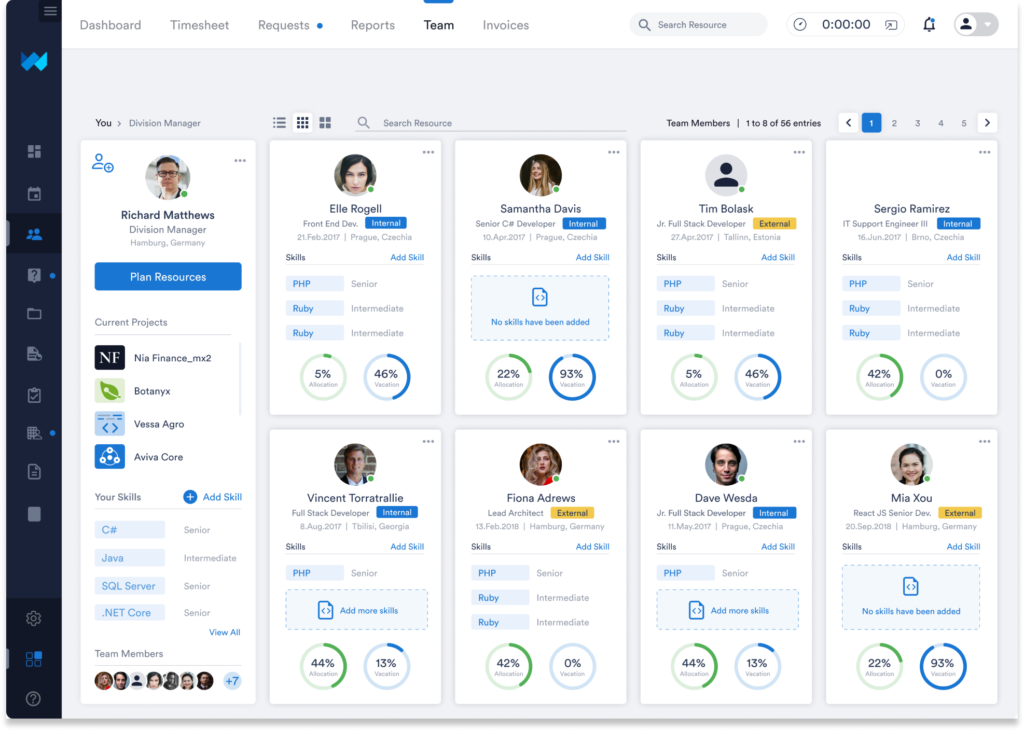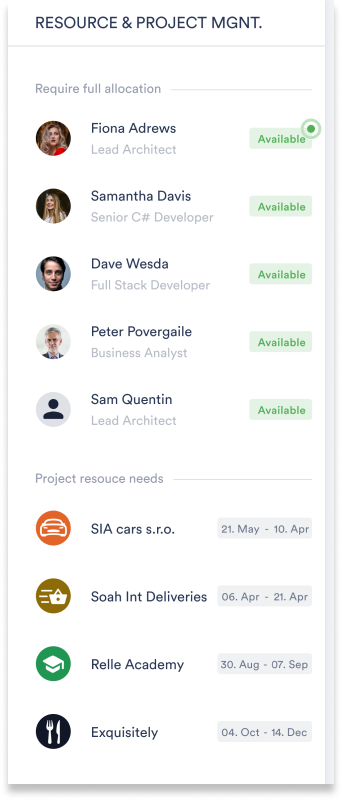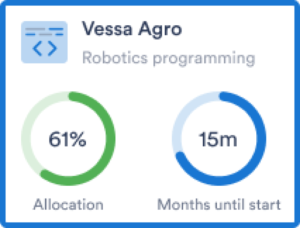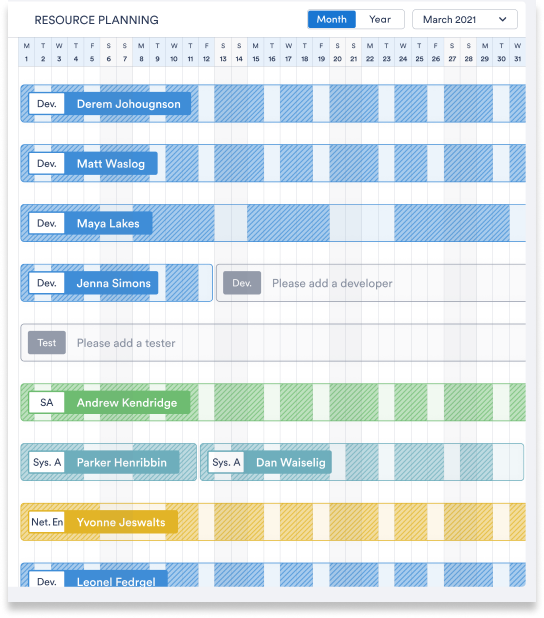Delivering quality is challenging. Without a resource planning process in place, achieving your project’s objectives will be even more challenging. Fulfilling your customer’s needs? Very unlikely.
Set yourself up for success in 2022 with a solid resource planning strategy. In this article, we will explore what resource planning is, and why there is a need for resource planning. We will look into the unfortunate results of poor resource planning, and steps for effective resource planning.

Resource planning definition
Resource planning is strategic and systematic thinking focused on deciding on how to make the most effective use of your resources. In the context of project management, resources are the people! So, your potential and/or current project team members.
Simply put:
Get the right number of the right kind of people each doing the right work at the right time.
These ‘4 rights’ are planned within operational constraints such as budget and time.
The right kind of people? This refers to the skillset of each person. Whether the skillset meets a need of the project tasks and objectives, and if this person is available.
What about the right place? Well, we used to think about the right place, too. But, now in 2022, we have a wealth of incredible online communication tools at our disposal. Often, we can now look at physical location as optional. Co-location may matter depending on the project, but it’s no longer an absolute necessity.
Careful! Good resource planning does not mean doing all the planning before a project starts. Agile resource planning allows for some planning at the start. But, continual re-planning and adapting as necessary during the execution of your projects are just as important.
4 reasons why projects need resource planning
Thanks to well-thought-out resource planning you organize your team so that each team member functions as effectively as possible.
1. Maximize resources.
One mistake with resource planning is to wait too long to do it. When you do it at the last minute you might not be able to allocate the right person to the right task. Resource planning needs to start well before the project actually kicks off. Then revisit the resource planning throughout the project’s cycles. Doing that with enough time and foresight gives you space to identify upcoming resource needs. Maximize your resources simply by planning resources wisely. A nimble resource planning tool lets you plan and adapt whenever you need to. In turn, you add value to your customers earlier and more often.

2. Save money.
Another way to say this directly is ‘Don’t waste money!’ Your project is bound by a budget and time, so when you maximize your resources you are effectively reducing waste and minimizing costs.
3. Improve business results.
Having projects in the pipeline is good for business! Good resource planning means you are able to plan well before a project starts and even set up multiple simultaneous or overlapping projects. Do you have the resources you will need? Are they skilled or need to get skilled up? Are there resources that can be redeployed? Do you need to look externally as well as internally? Good resource planning lets you tackle all these questions before they sneak up on you. And a useful resource planning tool makes managing many projects with loads of resources easy and efficient. The point is: the better the resource planning the more projects you can have in your pipeline. You’ll have a better idea of realistic timing for those pipeline projects. This means you can realistically take on more business.
4. A stronger workforce means better projects.
Success builds on success. Your team members know if a project is organized well or not. Strong organization – in this case meaning the resources knowing what to do, when, and why – leads to more job satisfaction. Happy team members lead to talent retention. That leads to stronger more experienced teams for future projects. A good resource planning tool will give you and your team a transparent, up-to-date, changeable, and easy-to-understand organization.
10 results of poor resource planning
Poor resource planning has many negative consequences. Nobody is perfect, but being aware of potential pitfalls will help you avoid them.
Inappropriate resource allocation.
The opposite of the right people doing the right things.
Did you plan an external resource when you had an internal one on the bench? You’ve just lost money. Did you plan a resource you assumed had the skills, but really didn’t? Oh no! You’ve just lost money and delayed the outputs. These mistakes can happen if skillsets and capacities are not analyzed, assessed, and understood properly. If you plan the wrong person for the wrong task, it’s hard to imagine that the task will fulfill the objective and meet the expected level of quality.
Getting stuck and/or off-target.
In traditional project management approaches, managers make a plan and stick to that plan. This means you assign resources at the start, and that’s that. This sort of inflexibility with resources (not adapting your resources to changing needs) can actually result in improper allocation and waste throughout your project. Your resources might be working on something unnecessary, or might be doing nothing while waiting for the next part of the plan.
The last-minute fudge.
Above we mentioned the need to start resource planning early in the pipeline and revisit often during a project’s life cycle. Ignoring these suggestions results in the last-minute fudge, where you just throw whatever resource with capacity at the problem. Is that the best resource for the task? Probably not! Good resource planning is like focusing on prevention, rather than a cure.
Procedural error.
A last-minute fudge might also result in making a procedural error, or even a violation of the company’s processes, or perceived or real unfair actions to solve the issue. This could, depending on the company, result in disciplinary action. You don’t want to find yourself in that situation because of poor planning.
Uneven workload.
Poor allocation of resources can result in an uneven spread of workload across your team. This is when some resources have too many tasks while others do not have enough. This can happen at the start or while the project is in the pipeline. But, it sometimes only becomes clear while doing tasks. Do you need more resources for certain tasks? Can portions of someone’s capacity be re-allocated to another project?
Double-booking.
An inability to quickly know when someone has been allocated can result in double-booking. If your team member is double-booked this will get flagged up eventually. You’ll be back to the drawing board looking for an available resource and lose precious time. Remember, the clock is always ticking!
Burn out.
Team member burn-out results from an uneven workload or unresolved double-booking. If someone is allocated too much work, or not enough time to do it, burnout and demotivation can occur. Managing a project is not just delivering the product, but also maintaining and supporting the well-being of your team members.
Related article: Handy tips on how project managers can avoid getting stressed out
Friction.
Another result of uneven workload or inappropriate resource allocation can be friction between your team members. Or even negative energy directed at the project manager or company itself.
Lags and Costs.
Any of the above can cause what you want to avoid the most: delays and going over budget. Your customer will be far from happy. Your team will be frustrated. And, your company will doubt your project management skills.
Failure!
The worst-case scenario is outright failure. Burnt-out. Over-budget. Overdue. Disaster! Delivering poor quality, or even delivering nothing at all. Not only could this affect the current project, but it may damage your company’s reputation as being a reliable partner. The long-term business consequences could be devastating. The result you didn’t plan for!
Now, let’s take a look at steps in the resource planning process that will help you mitigate the risks of poor planning.
5 steps involved in the resource planning process
To implement your resource planning strategy, break things down into several steps. This gives you a deliberate, thoughtful, and proactive approach. Remember, in an agile framework resource planning means you will revisit the steps throughout your project’s life cycle. Always remember: the planning never really finishes. This also means the steps below are not prescriptive. You may need to adapt and deviate, run in parallel, or shift the order at times. Manage the steps, don’t be managed by the steps!
Step 1: Assess the project’s demands and the customer’s needs.
You may not know all of the solutions at this stage, but it is the starting point. The main objectives of the project, how those fit the customer’s needs, and what sort of potential solutions might be delivered help you get an idea of what skillsets could contribute to the successful project. Also, consider the budget and the time constraints or deadline. And, understand how the project fits in your company’s project pipeline.
Step 2: Assess what you have.
Identify your current resources: their skillsets, capacity, salary/hourly wage, upcoming holidays, contract start/end dates, agreed working days, etc. Is there a cross-over with other projects? Can some tasks be done simultaneously, or staggered with lead time? What dependencies are there?
Then, identify any external resources you may need to bring in to fill any skills or capacity gaps. Regarding skillsets your project needs, keep in mind, you may not know all the solutions at this stage. This means you might not know all the resource skillsets you’ll need before you are underway. Cyclical re-planning and adjustments will address that during the project’s duration.

Step 3: Allocate!
Use the knowledge from Step 1 to create and make use of a project task list and task timeline. This may be more or less complex depending on the project. Use the knowledge from Step 2 to allocate resources and identify resource gaps. If allocation can be done through team decision-making, all the better! Budget time and money throughout your allocation process.

Start processes to get outstanding resources you know you need. These processes may be simple (do you have the authority to hire the right freelancer on a fixed short-term contract?) or, more complex, involving cross-departmental work (eg, HR team involvement, onboarding, etc.). The point is that these processes will vary from company to company, so understand how to get new resources and allow the right amount of time.
Related post: How does resource scheduling tie to project priority?
Step 4: Ensure clarity for the project team.
Transparency from start to finish is key to success. Resources should have clarity of expectation, success criteria, what other members of their team(s) are working on, milestones achieved to date, and the ability to track their own work. A shared, accessible resource planning tool can help.
Step 5. Monitor continually.
Don’t just set your project in motion. Resource planning is a continual effort and you must know what is happening. Monitor, monitor, monitor! Maintain a high frequency of interaction with the customer. Have regular team meetings to stay up-to-date on emerging resourcing needs. The more collaboration, the better! Continual monitoring puts you in control so you can address resource issues head-on before it’s too late.

Weekwise: the resource planning tool for agile teams
It’s clear now that good resource planning is essential – without it, your projects will suffer. Traditional planning spreadsheets will slow you down and leave you in the dark.
Resource planning nowadays is easier and more efficient with the right tool.
Weekwise is the perfect cloud-based tool for supporting your resource planning process. Weekwise helps you exploit all the benefits of effective resource planning while avoiding the pitfalls of poor planning.
With Weekwise’s resource planning & management tool it is easy to match your task lists with your resources’ skillsets, capacities, or scheduling considerations (like holidays). Weekwise’s weekly structure lets you adaptively plan and re-plan your resources as much or as little as needed for each project. The built-in timesheets and invoicing tools let you monitor incoming payments and outgoing fees for each project. Weekwise shows you as many projects and their resources as you need to know about – no more muddling around with numerous spreadsheets. Resource issues are transparent: Weekwise flags up which teams need support, or which projects may have become overstaffed.
Weekwise is a powerful resource planning tool that saves you time, lets you calmly and confidently complete current projects, and plan for your next winning project.